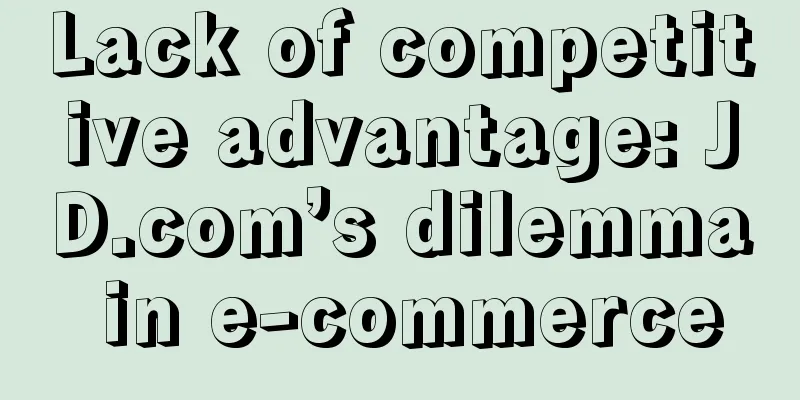"Omni-channel" and "one-stop product management" in new retail

1. Sales channels in new retail businessIn the new retail business, there are many sales channels. Different sales channels have their own business characteristics, so the corresponding marketing methods, operating methods, supply chain response methods, etc. are also different. The more common sales channels are: store retail, selling goods in physical stores (including franchised and directly operated chain stores); e-commerce sales channels, selling goods on e-commerce platforms represented by Taobao, Tmall, JD.com, Pinduoduo, etc.; emerging traffic positions, selling goods on emerging traffic platforms represented by Douyin live broadcast, Xiaohongshu live broadcast, Kuaishou live broadcast, etc.; distribution channels, selling to 2B customers such as agents, distributors, etc. in various places; The sales channels of new retail are very diverse. No matter which sales channel is used, the essence is to be consumer-centric and provide consumers with convenient, excellent and seamless shopping experience. Based on this concept and method, there is also a corresponding concept in the retail field: it is called "omni-channel retail." 2. What is omni-channel retail?Omni-channel retailing is a retail strategy that aims to provide customers with a seamless shopping experience, no matter which channel they choose to interact or purchase through. This model emphasizes consistency and coherence across channels, ensuring that customers can enjoy the same high-quality experience whether they shop in physical stores, websites, mobile apps, social media or any other touchpoints. Omni-channel does not mean that brands use all channels for sales, but that brands can choose, combine and integrate more channel types, so as to integrate channel advantages and share channel costs, and create a richer scenario-based consumption experience for consumers. The development of omni-channel Thierry Burdin, product retail director of French management software company Cegid, believes that omni-channel retail is the result of the evolution from mono-channel to multi-channel, then to cross-channel, and finally to omni-channel. Each stage is represented by a combination of brick, mortar, click and mobile.
Excerpted from "https://www.youxin.cloud/23.html" Omnichannel focuses on how multiple channels and customers interact with each other. A successful omnichannel setup can keep customer data and product data synchronized across channels. The ultimate goal is to provide customers with the greatest convenience and make every interaction between customers and brands in different channels a seamless experience. Omnichannel retail is sometimes called "seamless retail" or "unified retail." Extracted from "https://36kr.com/p/1549635494872449" 3. What is the difference between multi-channel retail and omni-channel retail?Although multi-channel retailing and omni-channel retailing sound similar, they are significantly different in their strategic goals and execution methods. 1. Multi-channel Retailing(1) Core features
(2) Case description Assuming a clothing brand operates in a multi-channel retail model, it may have the following channels:
Customers can shop on any of these channels, but each channel may have different promotions, prices, and inventory. For example, a physical store may have some limited-time discounts, while an e-commerce site may offer free shipping. Customers' experience is inconsistent between channels, and they may need to log in to different platforms separately to view information or complete a purchase. 2. Omni-channel Retailing(1) Core features
(2) Case description Continuing with the clothing brand example, assuming the brand adopted an omnichannel retail model, it would work like this:
3. ConclusionMulti-channel retailing emphasizes covering the widest possible customer base through different sales channels. Each channel may operate independently, and the customer experience between different channels may be inconsistent. Omnichannel retail focuses on consistency and continuity across channels, ensuring that customers can enjoy the same experience no matter which channel they shop in, achieving truly seamless shopping. The omni-channel retail model focuses more on providing a seamless customer experience, while multi-channel retail focuses more on covering a wider customer base through multiple channels. Omni-channel retail requires companies to have higher technical levels and more complex supply chain management capabilities, but it can also bring higher customer satisfaction and loyalty. 4. What is a batch of goods?Omnichannel unified inventory is a retail supply chain management strategy, the core concept of which is to centrally manage all inventory resources of an enterprise to achieve unified inventory allocation and optimization. This strategy allows enterprises to flexibly allocate goods between different sales channels (such as online shopping malls, physical stores, mobile applications, etc.) to meet the needs of consumers in different channels. Take a clothing retailer as an example. They may have multiple stores across the country and an online store. By implementing an omni-channel one-stop strategy, when a customer places an order for a piece of clothing online, the system will automatically check the inventory of all channels and select the nearest warehouse or store for delivery. Consumers can even choose to pick up the item at the nearest store. This not only improves the efficiency of inventory utilization, but also enhances the customer's shopping experience. Simply put, the goal of having one inventory system for all channels is to meet the inventory needs of multiple sales channels in actual business by centrally managing inventory and uniformly scheduling and allocating inventory. 1. The core features of a single batch of goods(1) Inventory sharing: All sales channels can share the same inventory, ensuring real-time update and accuracy of inventory data. No matter which channel the customer places the order from, they can immediately know whether the product is in stock. (2) Channel sales: Goods can be sold on any channel without restriction. For example, customers can place an order online and choose to pick it up at the nearest physical store, or buy it directly in the physical store. (3) Inventory optimization: By centrally managing inventory, inventory resources can be allocated more efficiently, reducing inventory backlogs and out-of-stock situations. Use data analytics to forecast demand and dynamically adjust inventory levels. (4) Flexible delivery options: Provide multiple delivery options such as order online and pick up in store (BOPIS), order online and deliver to home, return to store, etc. Customers can choose the most suitable option based on their needs and preferences. 2. Practical ExamplesLet’s say a clothing brand adopts an omnichannel inventory management model. Here’s an example of how it works:
5. What systems are needed for “one inventory across all channels”?In order to achieve a single inventory, enterprises usually need a powerful information system to support inventory management, order processing, logistics and distribution, etc. These systems include but are not limited to:
The current mainstream practice on the market is to place the "inventory center" in the OMS system, and connect the OMS with the downstream WMS and the store's POS system. It can not only obtain order data from multiple sales channels, but also obtain inventory data of all stores and warehouses through interfaces and document processing logic. For related business processes and product architectures, you can refer to systems such as Shangpai OMS, Bojun OMS, and Yum! Brands Omni-channel Middle Office. Assume that a retail company adopts an omni-channel inventory management model:
Through the efficient collaboration of these systems, enterprises can achieve efficient management of all channels and improve customer satisfaction, while reducing inventory costs and improving supply chain efficiency. 6. ReferencesIn the new retail business, we can hear the terms "omni-channel" and "one-stop shopping" very frequently. However, the definitions and explanations of these concepts in the market are also different. As a result, some newcomers will be very confused when they first learn about this business knowledge. It seems that the definitions are very high-sounding, but the actual output solutions are not so high-sounding... This article quotes a lot of external information and AIGC content. On the one hand, I am also confused by these terms and concepts, so I hope to use some slightly authoritative or convincing cases to answer these doubts. On the other hand, articles about concepts and noun definitions are more difficult to write, and the choice of words and sentences are time-consuming and laborious, so I just "stand on the shoulders of giants" and hope that everyone can understand. The following are some of the sources cited in this article. Interested friends can read the original text in detail to have a deeper experience. https://36kr.com/p/1549635494872449 https://www.youxin.cloud/23.html https://sleekflow.io/zh-cn/blog/omnichannel-marketing https://www.shopex.cn/news/archives/16674.html https://merchants.ubereats.com/us/zh/resources/articles/what-is-bopis-buy-online-pickup-in-store/ |
>>: Is the private domain outbound calling traffic generation method “dead”?
Recommend
Five steps to do an excellent data analysis project
In the field of data analysis, how to design and e...
Hot articles fail to bring conversions? How to deal with it?
Many times, Xiaohongshu notes are very popular, bu...
Fake charity short video, a mess
On short video platforms, some people may have see...
To seize the opportunity of Xiaohongshu, you must seize the opportunity of store broadcasting
This article will delve into the rise of store bro...
Why is my eBay account frozen? What should I do if my eBay account is abnormal?
Having your eBay account frozen is very difficult ...
Why are there fewer and fewer advertising buzzwords nowadays?
Unlike in the past, emerging consumer brands can s...
Alibaba International Station issues a recall notice for retro floor lamps
In order to safeguard the rights and interests of ...
How much commission do new Amazon operators usually get? Is the salary high?
There are still many merchants in China who sell o...
Taotian's "interconnection" business philosophy: 150 million new users, 2 trillion incremental GMV
In the prelude to Double 11, Taobao and Tmall open...
This is the most complete guide to sorting out the data indicator system!
The data indicator system is an important tool for...
What is Amazon's follow-up sales? Why does it happen?
Amazon's follow-selling model is reasonable an...
Will advertisers’ marketing budgets continue to decline in 2024?
In the past two years, the global advertising mark...
How many days can Amazon products be returned without reason? How long can a product be returned?
As one of the world's largest e-commerce platf...
How to build a corporate strategy house?
The corporate strategy house is a basic requiremen...
Is there a high demand for short videos on Amazon? What are the results?
Nowadays, it is quite popular to sell goods throug...









